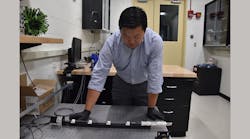Materials that can change shape under magnetic fields might sound like something out of a science fiction story, but the Air Force Research Laboratory (AFRL) is exploring the potential use of such materials in tunable components that might help with vibration absorption and suppression in vehicles. Working with academic colleagues at the University of Wisconsin (UW), the AFRL is studying a family of soft magneto-active composites that can reversibly change form, enabling them to switch between multiple shapes. The elastomer composites exhibit an increase in stiffness and change in shape in response to an applied magnetic field so that they can be actively tuned. By tuning the materials with magnetic fields, they may be suitable for such applications as filters and vibration dampers that can be adjusted with noncontact tuning. In the figure above, Dr. Vincent Chen, an AFRL scientist, is applying a magnetic field to change the shapes of various magneto-active composite materials.
Details on these novel magneto-active materials were recently published in the physics journal, Physical Review Letters (April 14, 2020 issue). The research examines the interactions between different mechanical instabilities and magnetic fields and how they can be applied as practical solutions for vehicles, such as for vibration suppression and dampening.
Contributors to the research include Dr. Stephen Rudykh from the University of Wisconsin, who noted that the AFRL and the University plan to build on the basic ideas of the study to develop reconfigurable forms for new function. He said: “The design space for architected elastomers is very rich, with additional mechanisms for magneto-mechanical interactions to be discovered and harnessed for applications.” Co-author D. Abigail Juhl from the Materials and Manufacturing Directorate of AFRL added: “We are excited about the potential for magnetic tuning to improve vibration sensing and control in aircraft and other vehicle environments.”
